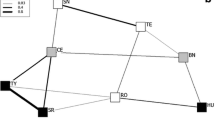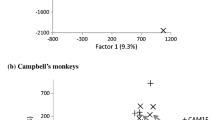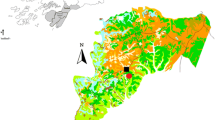Abstract
Kinship plays an important role in the social behavior of many primate species, including patterns of intra-group affiliation and cooperation. Within social groups, kinship is strongly affected by dispersal patterns, with the degree of relatedness among group-mates expected to decrease as the tendency to disperse increases. In primate species characterized by bisexual dispersal, relatedness among adult group-mates is predicted to be low, with social interactions shaped largely by factors other than kinship. To date, however, few studies have examined the role of kinship in social interactions in bisexually dispersing species. Accordingly, we collected genetic, spatial and behavioral data on all adult members (three males, six females) in a group of free-ranging mantled howler monkeys (Alouatta palliata) — a bisexually dispersing species of atelid primate — from Barro Colorado Island (BCI), Panama. Analyses of microsatellite variation revealed that relatedness was greater among adult males in this group (mean pairwise relatedness = 0.32 for males versus 0.09 for females). Relatedness among individuals, however, was not associated with either spatial proximity or frequency of social interactions. Instead, sex was a better predictor of both of these aspects of social behavior. While relatedness among adults had no discernible effect on the intra-group social interactions documented in this study, we postulate that kinship may facilitate affiliative and cooperative behaviors among male group-mates when interacting competitively with neighboring howler groups over access to food or potential mates.

Similar content being viewed by others
References
Altmann J (1974) Observational study of behavior: sampling methods. Behaviour 49:227–267
Bezanson M, Garber PA, Murphy JT, Primo LS (2008) Patterns of subgrouping and spatial affiliation in a community of mantled howling monkeys (Alouatta palliata). Am J Primatol 70:282–293
Brockett RC, Horwich R, Jones CB (2000) Female dispersal of the Belizean black howling monkey (Alouatta pigra). Neotrop Primates 8:32–34
Butts CT (2010) sna: Tools for social network analysis. R package version 2.2-0
Bygott JD, Bertram BCR, Hanby JP (1979) Male lions in large coalitions gain reproductive advantages. Nature 282:839–841
Calegaro-Marques C, Bicca-Marques JC (1996) Emigration in a black howling monkey group. Int J Primatol 17:229–237
Carpenter CR (1934) A field study of the behavior and social relations of howling monkeys (Alouatta palliata). Compar Psychol Monogr 10:1–168
Carpenter CR (1964) Grouping behavior of howling monkeys. In: Carpenter CR (ed) Naturalistic behavior of nonhuman primates. Pennsylvania State University Press, University Park, pp 386–391
Chapais B, Berman CM (2004) Introduction: the kinship black box. In: Chapais B, Berman CM (eds) Kinship and behaviour in primates. Oxford University Press, Oxford, pp 3–11
Chapman CA, Balcomb SR (1998) Population characteristics of howlers: ecological conditions or group history. Int J Primatol 19:385–403
Cheney DL, Seyfarth R (1983) Non-random dispersal in free-ranging vervet monkeys: social and genetic consequences. Am Nat 122:392–412
Clarke MR, Glander KE (2004) Adult migration patterns of the mantled howlers of La Pacifica. Am J Primatol 62:87
Clarke MR, Glander KE (2008) Natal emigration by both sexes in the La Pacifica population of mantled howlers: when do some stay? Am J Primatol 70:195–200
Clutton-Brock TH (1989) Female transfer and inbreeding avoidance in social mammals. Nature 337:70–72
Clutton-Brock TH (2009) Cooperation between non-kin in animal societies. Nature 462:51–57
Crockett CM (1984) Emigration by female red howler monkeys and the case for female competition. In: Small MF (ed) Female primates: studies by women primatologists. A.R. Liss, New York, pp 159–173
Crockett CM, Eisenberg JF (1987) Howlers: variations in group size and demography. In: Smuts BB, Cheney DL, Seyfarth RM, Wrangham RW, Struhsaker TT (eds) Primate societies. University of Chicago Press, Chicago, pp 54–68
Crockett CM, Pope TR (1993) Consequences of sex differences in dispersal for juvenile red howler monkeys. In: Pereira ME, Fairbanks LA (eds) Juvenile primates: life history, development and behavior. Oxford University Press, Oxford, pp 104–118
Dekker D, Krackhardt D, Snijders TAB (2003) Mulicollinearity robust QAP for multiple regression. CASOS Working Paper, Carnegie Mellon University
Dekker D, Krackhardt D, Snijders TAB (2007) Sensitivity of MRQAP tests to collinearity and autocorrelation conditions. Psychometrika 72:563–581
Di Fiore A, Fleischer RC (2005) Social behavior, reproductive strategies and population genetic structure of Lagothrix poeppigii. Intern J Primatol 26:1137–1173
Di Fiore A, Link A, Campbell CJ (2011) The atelines: behavioral and socioecological diversity in a New World radiation. In: Campbell CJ, Fuentes A, MacKinnon KC, Panger M, Bearder SK (eds) Primates in perspective, 2nd edn. Oxford University Press, Oxford, pp 155–188
Dobson FS (1982) Competition for mates and predominant juvenile male dispersal in mammals. Anim Behav 30:1183–1192
Ellsworth JA (2000) Molecular evolution, social structure and phylogeography of the mantled howler monkey (Alouatta palliata). Ph.D. thesis, University of Nevada
Glander KE (1980) Reproduction and population growth in free-ranging mantled howling monkeys. Am J Phys Anthropol 53:25–36
Glander KE (1992) Dispersal patterns in Costa Rican mantled howling monkeys. Int J Primatol 13:415–436
Glander KE, Fedigan LM, Fedigan L, Chapman C (1991) Field methods for capture and measurement of three monkey species in Costa Rica. Folia Primatol 57:70–82
Gouzoules S, Gouzoules H (1987) Kinship. In: Smuts BB, Cheney DL, Seyfarth RM, Wrangham RW, Struhsaker TT (eds) Primate societies. University of Chicago Press, Chicago, pp 299–305
Greenwood PJ (1980) Mating systems, philopatry and dispersal in birds and mammals. Anim Behav 28:1140–1162
Hamilton WD (1964) The genetical evolution of social behavior I and II. J Theor Biol 7:1–52
Hinde RA (1983) A conceptual framework. In: Hinde RA (ed) Primate social relationships. Blackwell, Oxford, pp 1–7
Hladik CM (1978) Adaptive strategies of primates in relation to leaf-eating. In: Montgomery GG (ed) The ecology of arboreal folivores. Smithsonian Press, Washington D.C., pp 373–396
Hopkins ME (2013) Relative dominance and resource availability mediate mantled howler (Alouatta palliata) spatial response to neighbors’ loud calls. Int J Primatol 34:1032–1054
Jack KM, Fedigan LM (2004) Male dispersal patterns in white-faced capuchins (Cebus capucinus). Part I: patterns and causes of natal emigration. Anim Behav 67:761–769
Jones CB (1980) The function of status in the mantled howler monkey, Alouatta palliata Gray: intraspecific competition for group membership in a Neotropical folivorous primate. Primates 21:389–405
Jones CB (1999) Why both sexes leave: effects of habitat fragmentation on dispersal behavior. Endanger Species Update 16:70–73
Kalinowski ST, Wagner AP, Taper ML (2006) ML-Relate: a computer program for maximum likelihood estimation of relatedness and relationship. Mol Ecol Notes 6:576–579
Kapsalis E (2004) Maternal kinship and primate behavior. In: Chapais B, Berman CM (eds) Kinship and behavior in primates. Oxford University Press, Oxford, pp 153–176
Kitchen DM (2004) Alpha male black howler monkey responses to loud calls: effect of numeric odds, male companion behaviour and reproductive investment. Anim Behav 67:125–139
Koenig A, Beise J, Chalise MK, Ganzhorn JU (1998) When females should contest for food—testing hypotheses about resource density, distribution, size and quality with Hanuman langurs (Presbytis entellus). Behav Ecol Sociobiol 42:225–237
Kowalewski MM, Garber PA (2010) Mating promiscuity and reproductive tactics in female black and gold howler monkeys (Alouatta caraya) inhabiting an island on the Parana River, Argentina. Amer J Primatol 72:734–748
Krackhardt D (1987) QAP partialling as a test of spuriousness. Soc Networks 9:171–186
Krackhardt D (1988) Predicting with networks—nonparametric multiple-regression analysis of dyadic data. Soc Networks 10:359–381
Langergraber KE, Mitani JC, Vigilant L (2007) The limited impact of kinship on cooperation in wild chimpanzees. Proc Natl Acad Sci 104:7786–7790
Langergraber KE, Mitani JC, Vigilant L (2009) Kinship and social bonds in female chimpanzees (Pan troglodytes). Am J Primatol 71:840–851
Leigh EG, Rand AS, Windsor DW (1982) Ecology of a tropical forest. Smithsonian Press, Washington, D.C.
Longmire JL, Lewis AK, Brown NC, Buckingham LM, Clark KM, Jones MD, Meincke LJ, Mayne J, Ratliff RL, Ray FA, Wagner RP, Moyzis RK (1988) Isolation and molecular characterization of a highly polymorphic centromeric tandem repeat in the family Falconidae. Genomics 2:14–24
McCann CM, Rothman JM (1999) Changes in nearest-neighbor associations in a captive group of western lowland gorillas after the introduction of five hand-reared infants. Zoo Biol 18:261–278
McFadden D (1974) Conditional logit analysis of qualitative choice behavior. In: Zarembka P (ed) Frontiers in econometrics. Academic Press, New York, pp 105–142
Meikle DB, Vessey SH (1981) Nepotism among rhesus monkey brothers. Nature 294:160–161
Melnick DJ, Hoelzer GA (1996) Genetic consequences of macaque social organization and behavior. In: Fa JE, Lindburg DG (eds) Evolution and ecology of macaque societies. Cambridge University Press, Cambridge, pp 412–422
Melnick DJ, Pearl MC (1987) Cercopithecines in multi-male groups: genetic diversity and population structure. In: Smuts BB, Cheney DL, Seyfarth RM, Wrangham RW, Struhsaker TT (eds) Primate societies. University of Chicago Press, Chicago, pp 121–134
Milton K (1980) The foraging strategy of howler monkeys: a study in primate economics. Columbia University Press, New York
Milton K (1982) Dietary quality and population regulation in a howler monkey population. In: Leigh EG, Rand AS, Windsor DM (eds) The ecology of a tropical forest. Smithsonian Press, Washington, D.C., pp 273–290
Milton K (1996) Effects of bot fly (Alouattamyia baeri) parasitism on a free-ranging howler monkey (Alouatta palliata) population in Panama. J Zool 239:39–63
Milton K, Lozier JD, Lacey EA (2009) Genetic structure of an isolated population of mantled howler monkeys (Alouatta palliata) on Barro Colorado Island, Panama. Conserv Genet 10:347–358
Miranda JMD, Passos FC (2005) Composicao e dinamica de grupos Alouatta guariba clamitans Cabrera (Primates, Atelidae) em Floresta Ombrofila Mista no Estado do Parana, Brazil. Rivista Brasilera de Zoologia 22:99–106
Nishimura A (2003) Reproductive parameters of wild female Lagothrix lagotricha. Int J Primatl 24:707–722
Oklander LI, Kowalewski MM, Corach D (2010) Genetic consequences of habitat fragmentation in black-and-gold howler (Alouatta caraya) populations from northern Argentina. Int J Primatol 31:813–832
Ostro LET, Silver SC, Koontz FW, Horwich RH, Brockett R (2001) Shifts in social structure of black howler (Alouatta pigra) groups associated with natural and experimental variation in population density. Int J Primatol 22:733–748
Packer C, Gilbert D, Pusey AE, O’Brian SJ (1991) A molecular genetic analysis of kinship and cooperation in African lions. Nature 351:562–565
Perry S (2012) The behavior of wild white-faced capuchins: demography, life history, social relationships, and communication. In: Brockmann HJ, Roper TJ, Naguib M, Mitani JC, Simmons LW (eds) Advances in the study of behavior, vol 44. Academic Press, Burlington, pp 135–181
Perry S, Manson JH, Muniz L, Gros-Louis J, Vigilant L (2008) Kin-biased social behavior in wild adult female white-faced capuchins, Cebus capucinus. Anim Behav 76:187–199
Pope TR (1990) The reproductive consequences of male cooperation in the red howler monkey. Behav Ecol Sociobiol 27:439–446
Pope TR (1992) The influence of dispersal patterns and mating system on genetic differentiation within and between populations of the red howler monkey (Alouatta seniculus). Evolution 46:1112–1128
Pope TR (1996) Socioecology, population fragmentation, and patterns of genetic loss in endangered primates. In: Avise JC, Hamrick JL (eds) Conservation genetics: case histories from nature. Chapman & Hall, New York, pp 119–159
Pope TR (1998) Effects of demographic change on group kin structure and gene dynamics of populations of red howling monkeys. J Mammal 79:692–712
Pope TR (2000) The evolution of male philopatry in Neotropical monkeys. In: Kappeler PM (ed) Primate males. Cambridge University Press, Cambridge, pp 219–235
Pusey AE, Packer C (1987) Dispersal and philopatry. In: Smuts BB, Cheney DL, Seyfarth RM, Wrangham RW, Struhsaker TT (eds) Primate societies. University of Chicago Press, Chicago, pp 250–266
R Development Core Team (2014) R: a language and environment for statistical computing, version 3.1.2. R Foundation for Statistical Computing, Vienna, Austria. ISBN 3-900051-07-0. http://www.R-project.org
Rumiz DI (1990) Alouatta caraya: population density and demography in northern Argentina. Am J Primatol 21:279–294
Ryan S, Starks PT, Milton K, Getz WM (2008) Intersexual conflict and group size in Alouatta palliata: a 23-year evaluation. Int J Primatol 29:405–420
Saavedra CJ (1984) Spatial and social relationships of males in two groups of red howler monkeys (Alouatta seniculus). M.S. thesis, University of Florida
Sekulic R (1981) Male relationships and infant deaths in red howler monkeys (Alouatta seniculus). Z Tierpsychol 61:185–202
Sekulic R (1982) The function of howling in red howler monkeys (Alouatta seniculus). Behaviour 81:38–54
Sikes RS, Gannon WL, Animal Care and Use Committee of the American Society of Mammalogists (2011) Guidelines of the American Society of Mammalogists for the use of wild animals in research. J Mammal 92:235–253
Silk JB (1987) Social behavior in evolutionary perspective. In: Smuts BB, Cheney DL, Seyfarth RM, Wrangham RW, Struhsaker TT (eds) Primate societies. University of Chicago Press, Chicago, pp 318–329
Silk JB (1994) Social relationships of male bonnet macaques: male bonding in a matrilineal society. Behaviour 130:271–291
Silk JB, Alberts SC, Altmann J (2004) Patterns of coalition formation by adult female baboons in Amboseli, Kenya. Anim Behav 67:573–582
Smith CC (1977) Feeding behaviour and social organization in howling monkeys. In: Clutton-Brock TH (ed) Primate ecology. Academic Press, London, pp 97–126
Smuts BB (1987) Gender, aggression, and influence. In: Smuts BB, Cheney DL, Seyfarth RM, Wrangham RW, Struhsaker TT (eds) Primate societies. University of Chicago Press, Chicago, pp 400–412
Smuts BB, Cheney DL, Seyfarth RM, Wrangham RW, Struhsaker TT (1987) Primate societies. University of Chicago Press, Chicago
Strier KB, Dib LT, Figueira JEC (2002) Social dynamics of male muriquis (Brachyteles arachnoides hypoxanthus). Behav 139:315–342
Trivers R (1985) Social evolution. Benjamin/Cummings Publishing Co, Menlo Park
Van Belle S, Estrada A (2008) Group size and composition influence male and female reproductive success in black howler monkeys (Alouatta pigra). Am J Primatol 70:613–619
Van Belle S, Estrada A, Strier KB (2008) Social relationships among male Alouatta pigra. Int J Primatol 29:1481–1498
Van Belle S, Estrada A, Ziegler TI, Strier KB (2009) Sexual behavior across ovarian cycles in wild black howler monkeys (Alouatta pigra): male mate guarding and female mate choice. Intern J Primatol 71:153–164
Van Belle S, Estrada A, Di Fiore A (2014a) Kin-biased spatial associations and social interactions in male and female black howler monkeys (Alouatta pigra). Behav 151:2029–2057
Van Belle S, Garber PA, Estrada A, Di Fiore A (2014b) Social and genetic factors mediating male participation in collective group defense in black howler monkeys. Anim Behav 98:7–17
Van Horn RC, Altmann J, Alberts SC (2008) Can’t get there from here: inferring kinship from pairwise genetic relatedness. Anim Behav 75:1173–1180
Wagner AP, Creel S, Kalinowski ST (2006) Estimating relatedness and relationship using microsatellite loci with null alleles. Heredity 97:336–345
Wang E, Milton K (2003) Intragroup social relationships of male Alouatta palliata on Barro Colorado Island, Republic of Panama. Int J Primatol 24:1227–1244
West SA, Pen I, Griffin AS (2002) Cooperation and competition between relatives. Science 292:72–75
White FJ, Chapman CA (1994) Contrasting chimpanzees and bonobos: nearest neighbor distances and choices. Folia Primatol 63:181–191
Widdig A, Nurnberg P, Krawezak M, Streich WJ, Bercovich F (2001) Paternal relatedness and age proximity regulate social relationships among adult female rhesus macaques. Proc Natl Acad Sci USA 98:13769–13773
Xia D, Li J, Garber PA, Sun L, Zhu Y, Sun B (2012) Grooming reciprocity in female Tibetan macaques Macaca thibetana. Am J Primatol 74:569–579
Zucker EL, Clarke MR (1998) Agonistic and affiliative relationships of adult female howlers (Alouatta palliata) in Costa Rica over a 4-year period. Int J Primatol 19:433–449
Acknowledgments
We thank the Smithsonian Tropical Research Institute and the Autoridad Nacional del Ambiente of Panama (ANAM) for their help and facilitation of this research. Special thanks to Vicente Jaramillo and Frederico Rodrigues for field assistance, to Dana Bardolf for assistance with data collection, to Paul Elsen for organizing the spatial and behavioral data for analysis, to Steve Selvin for statistical advice and to Tony Di Fiore for assistance with relatedness permutation analyses. For assistance with microsatellite analyses we thank Aimee Ellison. For insightful comments and suggestions, we thank the reviewers of this manuscript. Research funding was provided by the California Agricultural Experimental Station (KM and KE) and by the Museum of Vertebrate Zoology (EAL) at UC Berkeley. All work was conducted in compliance with national and institutional regulations and adhered to the legal requirements of the Republic of Panama, the American Society of Mammalogists’ guidelines for research involving live mammals (Sikes and Gannon 2011) and ASP principles for the ethical treatment of nonhuman primates.
Author information
Authors and Affiliations
Corresponding author
About this article
Cite this article
Milton, K., Nolin, D.A., Ellis, K. et al. Genetic, spatial, and social relationships among adults in a group of howler monkeys (Alouatta palliata) from Barro Colorado Island, Panama. Primates 57, 253–265 (2016). https://doi.org/10.1007/s10329-016-0523-5
Received:
Accepted:
Published:
Issue Date:
DOI: https://doi.org/10.1007/s10329-016-0523-5




